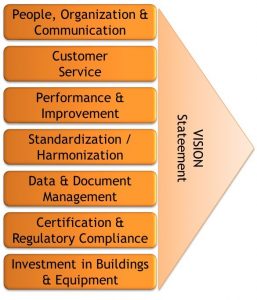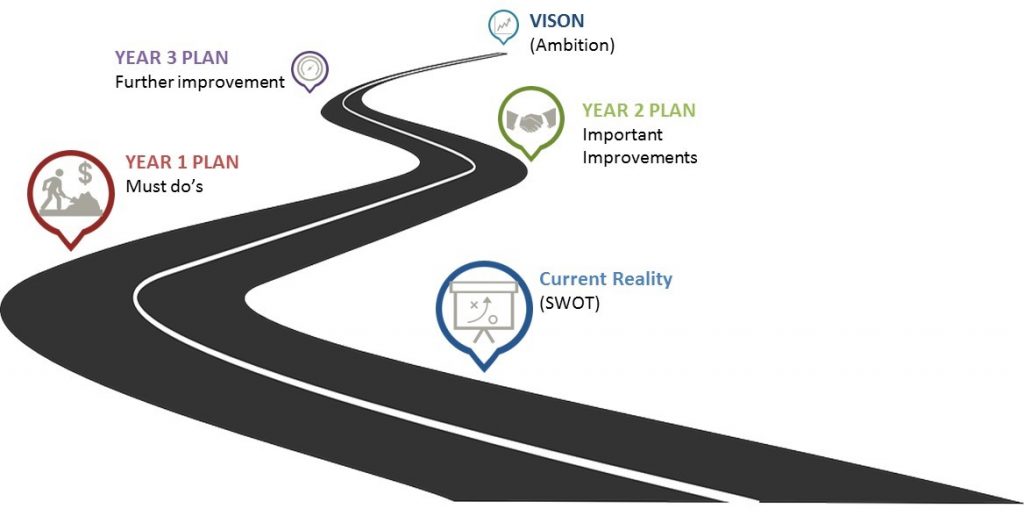Why you need a compelling multi-year plan
 A lot of companies do not know why they need to have clearly defined year plans which are written down, communicated to all employees and monitored on a continuous basis. Hence the results of these companies will be mediocre and if the results are good this is quite often a case of pure luck. Of course you don’t want to leave it up to luck as a manager. You really want to drive or results and get them!
A lot of companies do not know why they need to have clearly defined year plans which are written down, communicated to all employees and monitored on a continuous basis. Hence the results of these companies will be mediocre and if the results are good this is quite often a case of pure luck. Of course you don’t want to leave it up to luck as a manager. You really want to drive or results and get them!
Not only does not having a good plan lead to mediocre results, it also reduces the level to which you are being taken serious in the board room of the company. It even has an effect on how you are viewed upon as a person. Too often managers without a plan find themselves living from one issue to another, feeling continuous pressure and low job satisfaction. So, why you need a compelling multi-year plan…
One of the key principles for any field of management is to create a compelling long-term vision together with a good multi-year plan in order to give the organization focus and drive for results. This article explains the 5 essential must do’s for creating a compelling multi-year plan.
Preparation multi-year plan
As with all things, the result is often defined by the quality of the preparation. Before writing down the elements of a multi-year plan there is some crucial information to review first, including:
- Company mission, vision and strategy – you must ensure that whatever your department’s mission, vision and multi-year plan will be is fully aligned with the wider company perspective.
- Historical performance of your department – you want to review the last 3 years of performance data of your department or area of responsibility. Do include monetary expressions as much as possible (e.g. build on the Cost of Non Quality overview).
- Perform a team assessment including an activity analysis – this will give you good insight in the strengths and weaknesses of your team. See this article for more information.
- Any major issues you have been facing on your department and / or your area of responsibility over the last 10 years. This period is taken much longer as quite often big issues are less frequent, but should be taken into consideration when creating a multi-year plan.
 Once you have reviewed this information you should get together with a small group of ideally 3-5 people to create the initial view on your department’s mission and vision. On purpose you should start with the mission and vision as this defines your true ambition level for the future. In defining your vision true to be as complete as possible, as this will give you a good indication the major area’s you have to work in. As an example we show you a rather generic breakdown typically used for a QA/QC department.
Once you have reviewed this information you should get together with a small group of ideally 3-5 people to create the initial view on your department’s mission and vision. On purpose you should start with the mission and vision as this defines your true ambition level for the future. In defining your vision true to be as complete as possible, as this will give you a good indication the major area’s you have to work in. As an example we show you a rather generic breakdown typically used for a QA/QC department.
Before creating the multi-year plan there is one other essential step: analyse your current situation (or current reality) via a Strength-Weaknesses-Opportunities-Threats (SWOT) analysis. Then start building your multi-year plan through tackling all threats by combining these with the strengths or opportunities and at the same time address crucial weaknesses as well in the same way. This way you make as much use as possible of the strengths of your team and the opportunities you have to grab.
This exercise can be done in one day as it does not need to be 100% picture perfect. It even shouldn’t be, because this is just the starting point. From here you will need at least one or two iterations based on the next two steps in the process to reach your final version. In the next two sections we will describe these two steps.
Why year plan Stakeholder interviews
Once you have the first, crude version of your mission, vision and multi-year plan it is time to start discussing these with your stakeholders. Of course your line manager will be the most important stakeholder as he/she will judge your performance and your team’s performance at the end of the day. Next to your line manager you need to think what stakeholders are present in your company. A nice way to do this is to create a stakeholder map as shown below.

By dividing the stakeholders in groups with high/low interest in your area of responsibility and high/low power in the wider organization, you can filter really important stakeholders (high power with high interest and high power with low interest) from all the others.
The best thing to do next is to schedule interviews or conversation with the important stakeholders. You want to have their view on what are the issues at hand and the opportunities for the future. Be careful not to press your plans onto them, it needs to be a conversation where you can display your intent, but really ask them for their input. Don’t be afraid to ask for strong feedback as this will only give you a good view of what they deem really important and what less important. Before closing the discussion with a stakeholder, be sure to ask the single most important question: “ Do you agree with these plans and do you want me to deliver against them?”. This question should trigger any hidden opposition from the stakeholder against your plans. It will really help you as you cannot be successful on the long run if important stakeholders are not willing to see you succeed.
Based on the stakeholder interviews you can update your mission, vision and multi-year plan to draft version number two. But again, don’t get attach to your plans just yet. You still need to discuss everything with the most important stakeholders of all: your team – in the end it will be your team and you who are going to deliver the results or not.
Team Away Day
Once you have your second draft plan and have the green light of your most important stakeholders, it is time to start working with your team. The only true way work with your team is to start with a clean sheet of paper. This does not mean you throw away all the effort taken so far, but you are not going to share it with your team as a fact. You need to be aware that you have already started on a journey, where your team is still at the starting point. So you need to bring them along the same journey, albeit at a slightly higher pace.
The best way to engage your team is to organize a one or two day team event during which you are going through similar steps as you have, sharing a condensed amount of information with your team:
- Give a brief summary of the performance over the last 3 years and also include the major issues you have faced over the past 5 years in this as well
- Share a summary of the stakeholder feedback you have received and link it to the company mission, vision and strategy.
- Show the main building blocks which you are going to use in the process from here onwards – if the team has good motivations on changing these, do so as it will only help you increasing their level ownership of the entire plan.
This is as far as sharing of information should go, from here you want to build everything together with your team, starting with a the vision and mission (see picture below):
As you have prepared everything with a few people in your department you will find that the mission and vision will in the end be very close the text you have written before, but now it will be owned by all. Next you want to repeat the same process for the SWOT analysis. A good way of doing this is to facilitate this yourself, and if the team is bigger ask the others who prepared with you to facilitate as well. This way to enable all the other team members to give their input, only adding really important topics yourself which the team did not come up with.
Finally you can then start creating a multi-year plan. And the best thing to do not to end up with all the actions in year one is to put some structure around this as well: in the first year you should focus in the must do’s – these are the topics that must really be addressed now either for compliance reasons or because these are big saving opportunities that will fuel you program in years to come. In the second and/or third year you want to focus on the important areas to address and in the years after that (typically up to five years in the future) you plan all activities for further improvement.
In planning the tasks or projects, try to be realistic from the start – it is better to plan a longer period in time and over deliver that to plan too much into a short time and not being able to get to the results you are aiming for. There is no need at this point in time to create full project plans. You can consider though to spend some time during your workshop and identify a task / project owner for each task of project on the list in the first year.
Continuous Monitoring and Updating
 A big mistake which is quite often made is to start implementation and never evaluate. Some managers find themselves going through an annual cycle of creating nice plans and then going back to the daily reality without really thinking of their plans let alone delivering against them.
A big mistake which is quite often made is to start implementation and never evaluate. Some managers find themselves going through an annual cycle of creating nice plans and then going back to the daily reality without really thinking of their plans let alone delivering against them.
For you to be successful it is crucial to have continuous monitoring of the progress of your multi-year plan. There will be projects that go well and project which have delays and difficulties. By reviewing all project at least on a quarterly basis (and important ones on a monthly basis) you will stay on top of things. Next to progress you of course also want to look at the results you have achieved near the end of the projects or project phases. Reviewing your progress is important as this gives you input which you as a manager need to share with your stakeholders. You want to update your important stakeholders at least on a monthly basis on the progress you are making.
In almost every journey there will be set-backs: projects will delay and issues will arise. Of course it is important to manage issues, here you can read why. Also it is good to discuss these with the relevant stakeholders as you want to keep them aligned with your multi-year plan.
Sometimes you will find yourself in a situation where there is no other option than to adjust your plans. This is OK as long as you ensure you properly discuss this with your key stakeholders and openly discuss the reasons why with your team. Ideally you have 2 team away days per year, which allows you to perform an informal mid-year review with your team and update your plans accordingly after discussion. This way you keep your team’s ownership at a high level.
Integration with company mission and vision
If your company already has a clear mission, vision and strategy defined, it is of course very important to fit in and align with these as much as possible. It might even mean that you cannot choose the main areas of attention yourself (e.g. because these have been agreed collectively my senior management and need to be followed everywhere in the organization). This is not a real issue, because in the end the main areas are only there for communication purposes – most projects and activities can be placed in any set of high level areas.
The three things you need to be aware of in relation to your company’s mission, vision and strategic plans are:
- Do not create conflicts – you cannot drive your team in a direction that does not match the overall company direction. If you still feel this is a crucial thing to do you need to start discussing this issue with the relevant stakeholders first.
- Ensure you align in terms of timing and use of resources. When a company has strategic plans for each department, it is important to ensure all these plans are aligned in terms of timing and use of resources. For most projects you will need the participation of other departments. Hence you need to look at the interaction in a company-wide perspective.
- Also at a company level it is better to be less ambitious and deliver than for all managers to be highly ambitious and create an organization with too much stress and a track record of failure rather than success.
Finally if your company has a strong culture of strategic management, most likely there will be periodical updates to all employees (e.g. town hall sessions). Ensure your department is feature on a regular basis during these events as this will help you in re-enforcing the importance of your strategic plans to your team and the wider organization. When there are good results to present let the team do this – this is the ultimate recognition you can give to people: they can present the results they achieved in front of all their colleagues and they will also receive the positive feedback directly!
